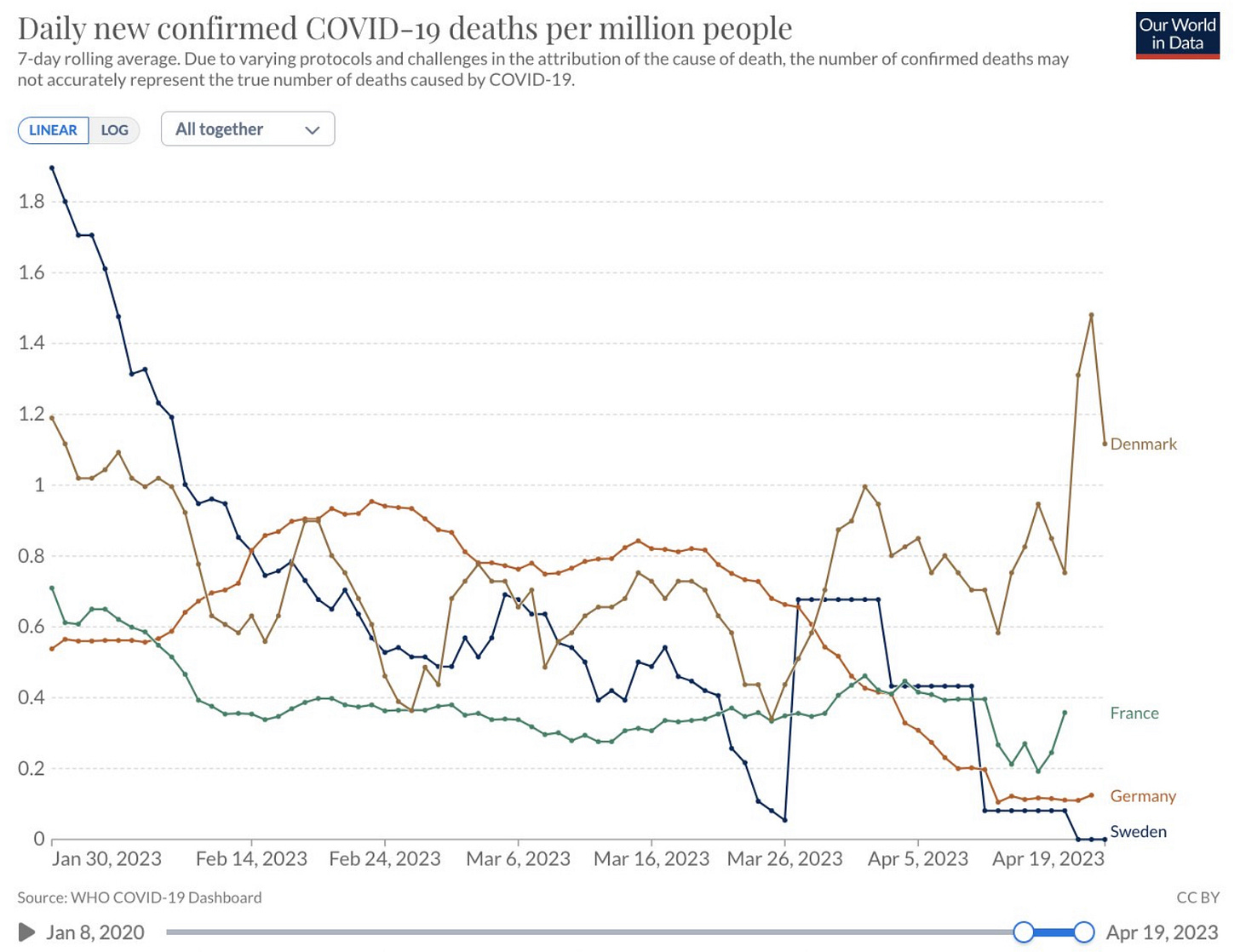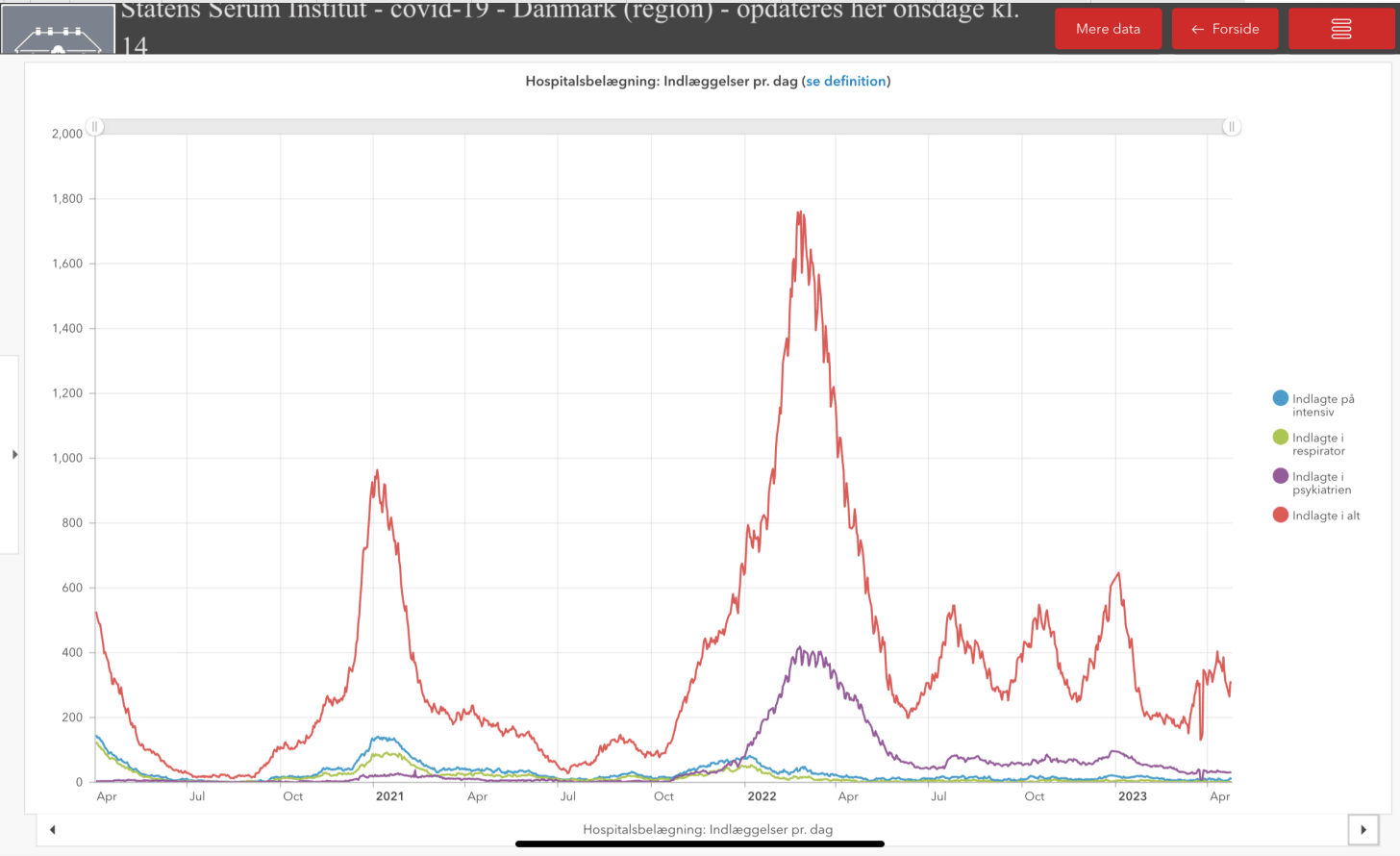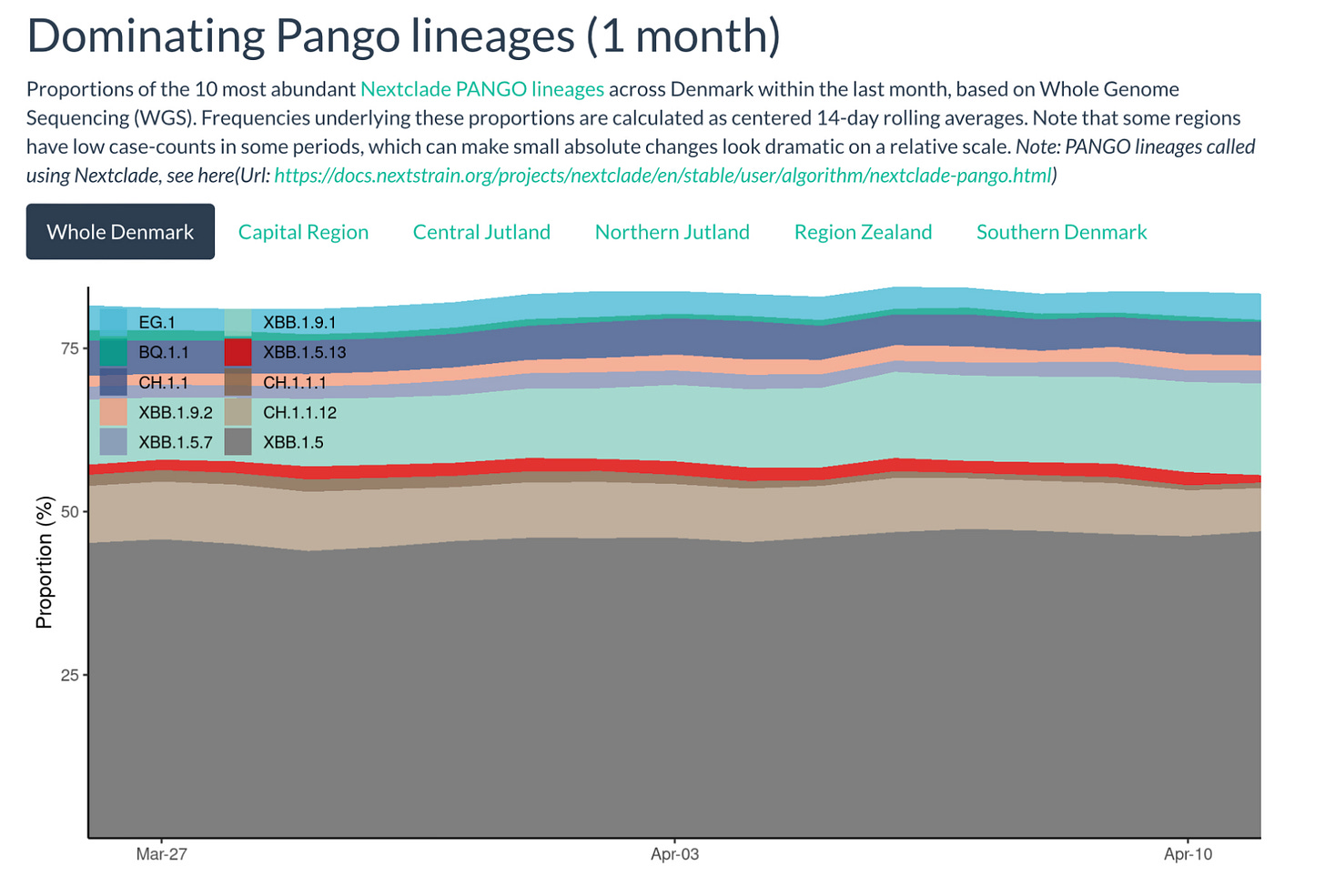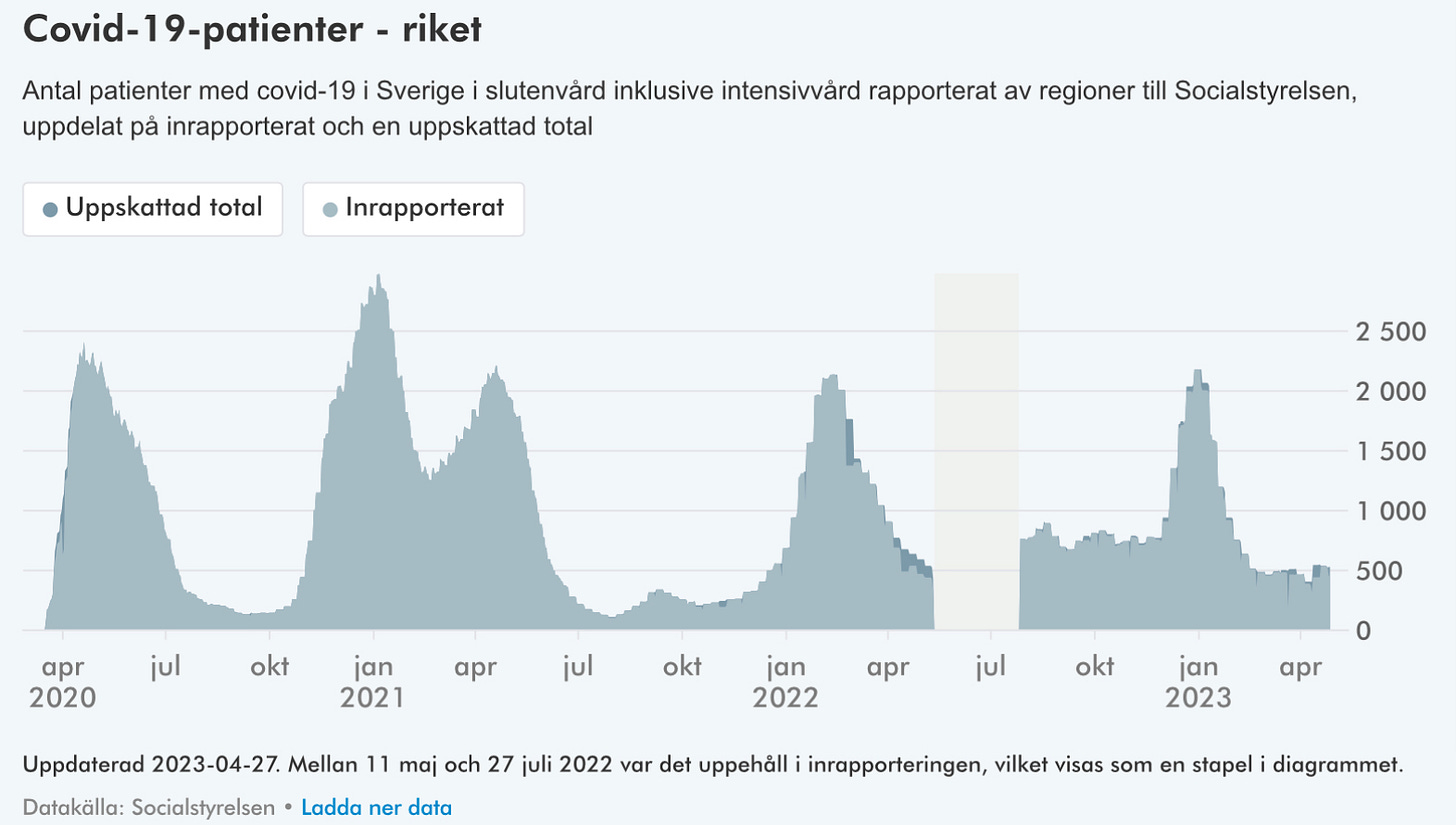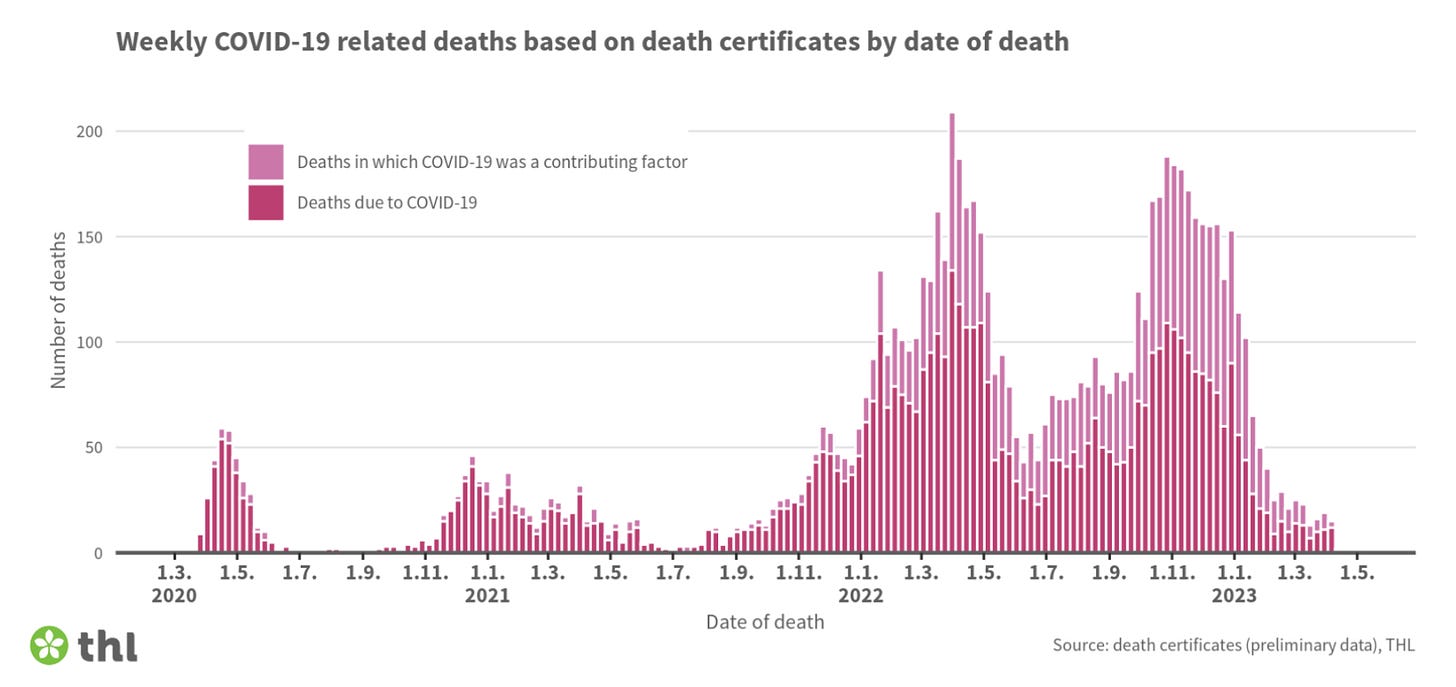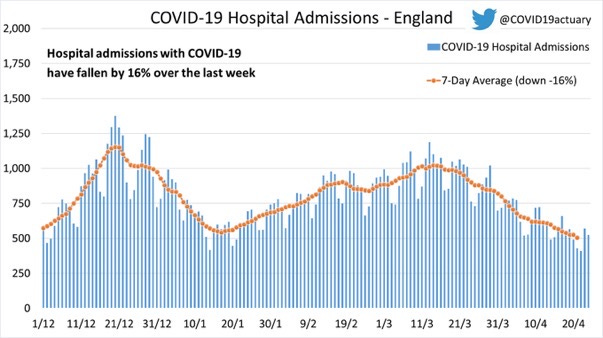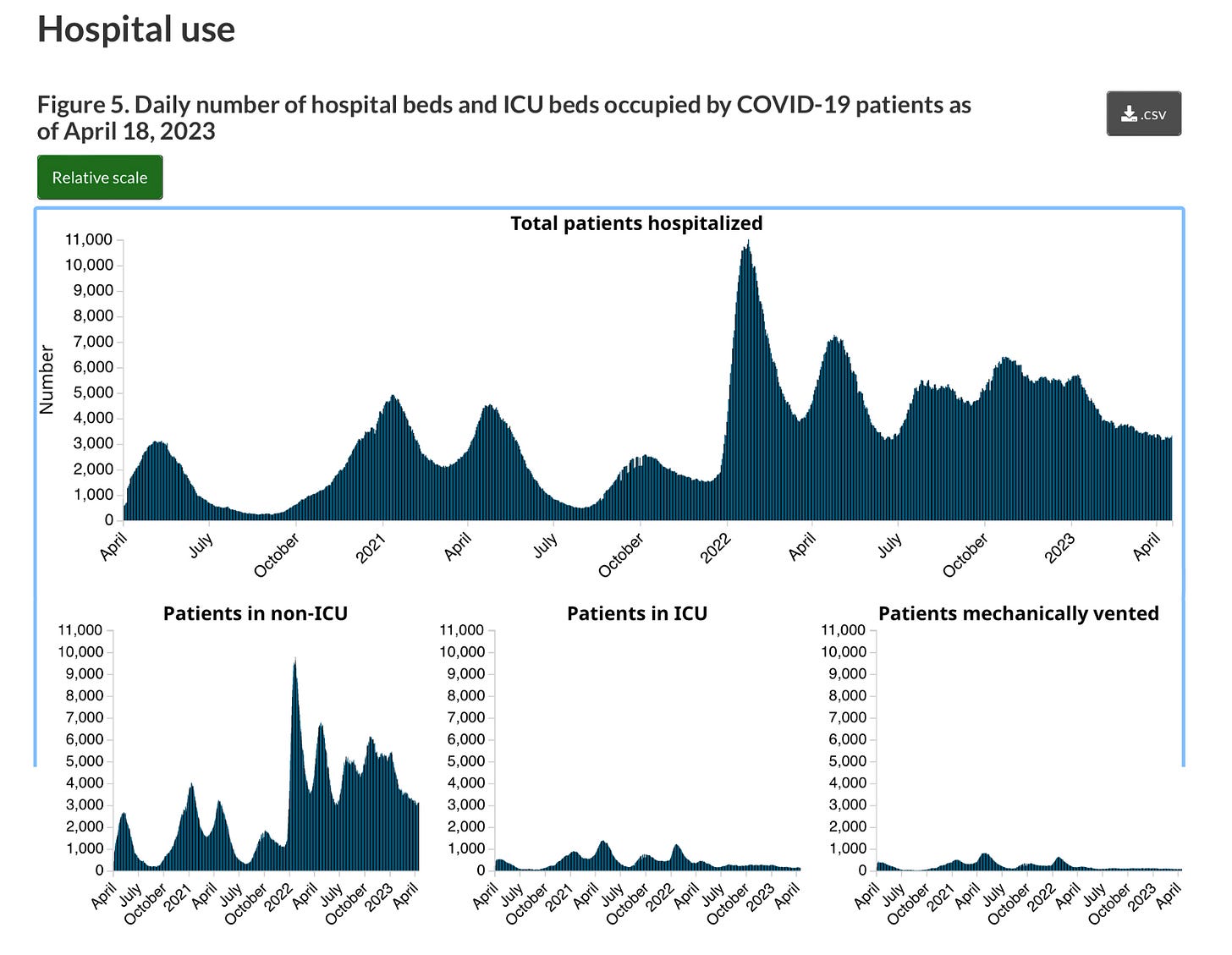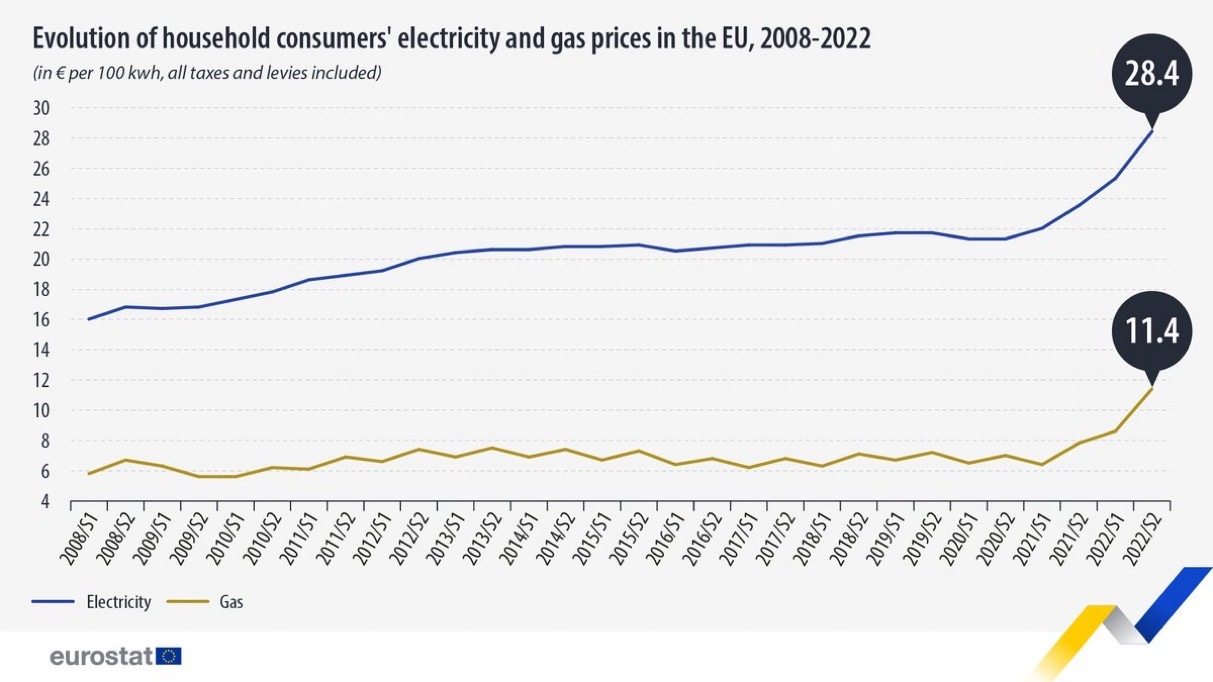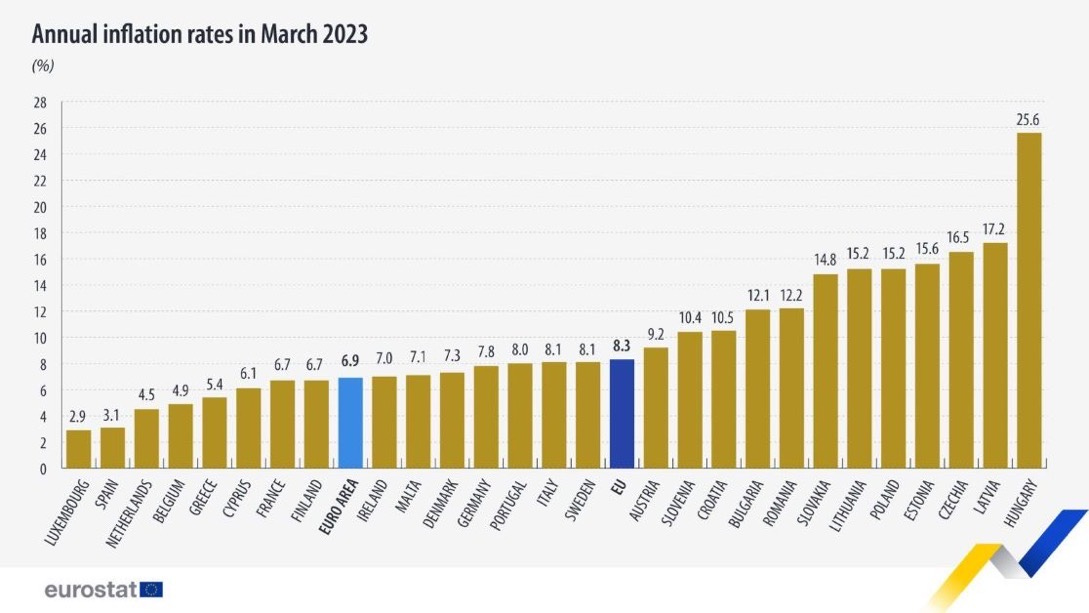The Evening Report - Apr 27
Denmark spends big bucks to fight pandemic. Europe leans on wind energy.
🦠Pandemic🦠
🇩🇰
University of Oxford Virology and Immunology Professor Astrid Iversen continues to warn that Denmark is making a mistake by not offering a spring booster dose to its most vulnerable populations. Iversen points to the disparity in COVID deaths between Denmark and other nearby countries like France, Germany, and Sweden, who are offering a spring booster dose to elderly seniors and those in senior care homes.
“In Denmark, the number of dead increases with a positive corona test, the pattern is different than in other countries, an explanation could be that many countries outside Denmark have given a spring booster to the elderly and the immunocompromised.”
Iversen, who was on a committee advising the Danish government on its pandemic response during the first two years of the pandemic, says the health officials in the country are blatantly ignoring the booster dose recommendations from the European Centre for Disease Prevention and Control.
-
While Denmark ends its public COVID testing regime, vastly scaled back coronavirus reporting, and embraces a pandemic strategy of pretending the pandemic is over the government’s new budget tells a different story. In this year alone it has allocated just over two billion Danish kroner (about $402 million Cdn) to fight COVID.
To put that into context that is the same amount the government has set aside over two years as an emergency fund for the entire healthcare system.
Of the two billion kroner, 635 million is for testing and infection detection even though Denmark has ended its public COVID testing program. 500 million is for just managing the pandemic this year. 21.6 million is for coronavirus research. And the largest line item is 883 million for vaccine purchases.
-
COVID hospitalizations (307) eased slightly (-3) while the number of severely infected people in an ICU (9) and of those, the number on a ventilator (1) are both unchanged day to day. The number of infection-related admissions to a psychiatric facility (31) decreased slightly (-1).
-
Denmark reported 783 new infections (wildly underreported), including 230 reinfections, and 52 more coronavirus virus deaths in the last week.
-
The seven-day positivity percentage is 13.4%.
-
The recombinant XBB variant continues to dominate in Denmark based on what little testing and sequencing is still being done. In particular, XBB.1.5 and XBB.1.9.1 are seeing the greatest growth. The Statens Serum Institute notes while infection numbers of XBB.1.16 are rising in other countries there have been “just a few cases” confirmed here in Denmark.
🇸🇪
The Swedish Public Health Agency has discontinued its COVID dashboard making it incredibly hard to get any idea of infection activity.
Hospital statistics are still being tracked. COVID hospitalizations (454) have fallen over the last week (-85) while the number of severely infected people in an ICU (13) has crept upward (+3).
-
As coronavirus infections rise in Sweden the country’s national healthcare agency is warning that far too many vulnerable seniors have yet to get their latest booster dose. The Swedish Public Health Agency says fewer than half of seniors over 80 have had their recommended number of booster doses. It is now working to remind high-risk seniors of the “urgent need” to get another booster dose.
Since another booster dose was offered on March 1, to seniors over 80 and all seniors in care, just 38% have had their top-up shot.
Unit Head Sören Andersson:
“People over 80 have an increased risk of serious covid-19. Some in this age group are in need of assistance to take part in the vaccination offer. We want to draw the attention of people over 80, their relatives and healthcare staff that it is important that this age group has access to vaccination.”
The public health agency says infection numbers have “increased slightly” in the last few weeks albeit from low levels. It does not provide any exact case numbers.
In Sweden, while most people deemed at risk will get an annual booster dose in the fall elderly seniors and those in care who are especially vulnerable can get boosted in the spring as well.
-
While the pandemic has set back childhood vaccination rates across some countries that is not the case in Sweden. The Swedish Public Health Agency says it hasn’t been easy but thanks to extraordinary efforts by pediatric healthcare staff, school health workers, and, of course, parents the vast majority of children have had their vaccinations on time. The agency says despite the pandemic 97% of children two years old have had all their shots on schedule.
It credits a high vaccination rate for making it extremely rare to see serious infections like measles, polio, or diphtheria in Sweden.
Director General Karin Tegmark Wisell:
“It is an impressive collaboration between child health care, student health, and parents that has taken place in the middle of the pandemic. That every child receives their vaccinations on schedule is crucial for their health for a long time to come.”
Wisell says in Sweden efforts are made in communicating vaccine information not just to parents or caregivers but also to the children themselves.
“Including children and young people in our information sharing is in line with the Convention on the Rights of the Child. It is also part of the work to increase knowledge and strengthen confidence in vaccinations as a tool for health throughout their life. Today, there are many children and adults who have not heard of these diseases, or know that you can get seriously ill from them.”
Sweden’s childhood vaccination program includes inoculations against 11 serious and contagious diseases. The agency credits the program for preventing tens of thousands of acute cases of illness in Sweden each year.
🇫🇮
Finland has registered 2,398 new infections (underreported) and another 93 pandemic deaths in the last week.
-
While the vast majority of people in Finland got vaccinated against the coronavirus a small number did not. In the largest study of its kind by the Finnish Institute for Health and the University of Helsinki analyzed why some people refused to get vaccinated.
Researchers poured over population data both before the pandemic and after the vaccination campaigns testing thousands of variables. They narrowed the focus to just those 30 to 80 years old. Researchers determined that factors potentially influencing a decision to not get vaccinated included earning a low wage, being from an immigrant family, having close relatives, especially a mother, who did not get vaccinated, drug abuse, and having mental health challenges.
University of Helsinki Institute of Molecular Medicine Ph.D. Researcher Tuomo Hartonen:
“The lack of salary can be due to either unemployment, illness, or retirement. In addition, our results showed that among wage earners, those with lower salaries took the first corona vaccine less often than others. Our research does not provide answers to what the connections we see are caused by. However, we can assume that, for example, it may be more difficult for those working in low-wage fields to fit the vaccination time into their own working hours. Challenges related to organizing vaccination or obtaining reliable information may especially concern those suffering from mental health and substance abuse problems. Foreign speakers, on the other hand, can find it more difficult to get information in their native language.”
The results of the study have been published in the journal Nature Human Behavior.
🇳🇴
Virus activity across Norway is at a low level and the pandemic situation overall at the moment is described as “relatively stable.” That is the assessment from the Norwegian Institute for Public Health in its latest bi-weekly update.
The NIPH says wastewater surveillance continues to show declining virus activity as it has since week 14.
The institute has mixed news on the hospital front with decreasing numbers of admissions directly because of a COVID infection. But there has been a slight increase in the number of patients being admitted for a variety of reasons who are testing positive.
Pandemic deaths in Norway have also increased slightly. Overall, excess mortality is within normal levels seen over the last ten years before the pandemic struck. The number of respiratory infection-related deaths has also been stable despite the slight uptick in coronavirus fatalities.
The health agency says XBB.1.5 remains the dominant variant in Norway but it notes increasing numbers of the subvariant XBB.1.9.
The NIPH says the flu season is in decline with cases falling below the outbreak threshold. That said, it warns influenza is still circulating, especially the B strain. There were 52 flu-related hospitalizations last week, 25 fewer than the week prior. There have been zero influenza-related intensive care admissions for two weeks running. The institute also laments the extremely low uptake for flu shots this year. 64% of vulnerable seniors got the jab while a mere 7.9% of children had an influenza vaccination.
Norway is also offering another COVID vaccine booster dose to seniors over 75 and all seniors in care if it has been more than six months since their last top-up dose.
-
The pandemic appears to have taken a toll on the mental health of older children and may be behind an increase in kids developing eating disorders. This is the finding from a review of 89 studies across the Nordics done by the Norwegian Institute of Public Health.
The institute says the wear and tear of the pandemic over time increased rates of anxiety, depression, and other negative developments among children over the age of 10.
Project Manager, and Researcher, Heid Nøkleby says as the pandemic trudged on mental health and inquiries for a variety of issues among children exceeded pre-pandemic levels.
Nøkleby says it is vital to continue studying pandemic impacts on children.
“This is important knowledge, both with regard to the follow-up of children and young people who have been particularly negatively affected and with regard to preparedness and efforts in the event of similar crises in the future.”
The research also notes that reports of child abuse and domestic violence were underreported due to lockdowns and other COVID restrictions reducing the ability of teachers, social workers, and healthcare staff to notice and report cases.
There was one positive outcome noted at the kindergarten level.
“Studies from kindergartners showed many positive experiences with the changes that were implemented in line with infection prevention measures, for example, smaller groups of children and more freedom to organize the day. Experiences from the schools, which were subject to greater restrictions, were far more varied.”
Researchers note that factors that may contribute to children being more vulnerable to declining mental health include poverty, immigrant backgrounds, learning disabilities, and those who are LGBTQ+.
🇫🇷
As of Thursday (April 27), the highest-risk populations in France will be able to get another COVID vaccine booster dose. This includes seniors over 80, seniors in care, people who are immunocompromised, and others battling chronic and underlying diseases.
The French health ministry says COVID booster doses will, as in other countries across Europe, become a regular part of the fall vaccination effort alongside influenza vaccinations. But additional doses could be offered as needed to the most high-risk populations depending on the outbreak situation.
🇬🇧
COVID hospitalizations are dropping in England. According to data from the COVID Actuaries Response Group infection-related hospitalizations have fallen by 16% week to week. Bed occupancy also fell by 14%. The declines were seen across every region of the country.
The reinfection rate, or R0, has also decreased to 0.92. Anything over 1 is seen as an increasing epidemic.
🇨🇦
The Public Health Agency of Canada has reported 6,300 new infections (underreported) and 110 more COVID deaths in its latest weekly pandemic snapshot. Total to date coronavirus deaths will soon pass 52,000.
The seven-day positivity percentage is 11.4%
-
COVID hospitalizations inched upward in the week ending April 18. There are now an all-in total of 3,333 beds being used by coronavirus patients, an increase of 65 from the week before. General admissions saw the biggest increase going from 3,115 to 3,193 from one week to the next. The number of severely infected people in intensive care decreased by 13 to 140. While the number of people requiring a ventilator rose slightly by four to 77.
Again it is worth noting the continued strain the pandemic has put on Canadian hospitals with the valley floor between infection waves holding stream at about 3,000 patients per day. This pressure on the healthcare system has continued unabated at its lowest point for almost a year and a half now.
⚡️Energy Crisis⚡️
🇪🇺
We are getting a clearer picture of the impact of last fall’s energy crisis and how high prices rocketed upward. European statistics agency EuroStat has released its latest numbers showing both gas and electricity prices across the European Union absolutely shattered records in the last half of 2022.
Across the EU household electricity prices rocketed to €28.4 per 100 kilowatt hour (kWh). During the same period in 2021, electricity prices were €23.5 per 100 kWh.
Gas prices also shot upward from €7.8 to €11.4 per 100 kWh.
At the country level, Romania (+112%), the Czech Republic (+97%), and Denmark (+70%) saw the highest increases in electricity prices last fall. On the gas use side, the Czech Republic (+231%), Romania (+165%), and Latvia (+157%) saw by far the highest increases in natural gas prices.
To emphasize the impact of the energy crisis pushing costs into the stratosphere, EuroStat notes that government attempts to shield households from soaring prices resulted in sharply dropping tax revenues on electricity and gas bills. The share of taxes on electricity bills dropped by 18.3% while gas bills saw a 15.4% drop in the share of taxes.
But EuroStat warns that government efforts to mitigate energy costs will come with future fiscal pain.
“These governmental measures, while lowering energy prices for the final consumer, have burdened governmental accounts.”
🇩🇰 🇳🇴 🇧🇪 🇬🇧 🇳🇱 🇫🇷 🇱🇺 🇩🇪 🇮🇪
Nine countries, including Denmark, have agreed to expand offshore energy production even more in the North Sea. In a summit in Oostende, Belgium this week the nine countries, Denmark, Belgium, Great Britain, the Netherlands, France, Luxembourg, Germany, Ireland, and Norway, agreed to increase offshore wind energy capacity to 130 gigawatts by 2030 and then to 300 gigawatts by 2050.
This builds on a plan announced last year to harness the North Sea as Europe’s green energy power plant in order to realize the energy transition and severe Europe’s reliance on Russian oil and gas.
Danish Prime Minister Metter Frederiksen:
“We are speeding up the green transition. The Danish government has recently doubled the sea area that is set aside for offshore wind so that we can reach the target.”
This expanded agreement makes the North Sea the largest energy-producing area in the world.
But realizing these goals will not be easy. I was in Oostende following last year’s declaration and talked to some of the players in the offshore wind industry. They told me there are major challenges. You can watch my video on the topic HERE.
🇪🇺
Inflation in the Eurozone fell to 6.9% last month from February’s 8.5% according to the European statistical agency EuroStat. Within the European Union, inflation also declined from 9.9% to 8.3% in March.
Across the individual EU member nations inflation fell month to month in 25 countries but rose in the other two.
Food, alcohol, and tobacco products continue to be an inflation driver (+3.12%) as are services (+2.10%) and energy (-0.05%).
🇪🇺✈️
A new deal has been reached among European Union member countries to ensure that passenger aircraft in airports across Europe increase the use of green fuels in order to reduce emissions produced by the aviation sector. Beginning in 2025, European airports must ensure that at least 2% of all fuel used is green, like synthetic electro fuels or certain types of biofuels. The floor will then be increased every five years to transition airports to becoming climate neutral by using green fuels 70% of the time by 2050.
The agreement must still be ratified by the European Parliament and each member state before it can come into force.
🇩🇪 🇩🇰
Energy companies from Germany and Denmark are working together on a hybrid power connector to bring offshore wind energy from the North Sea into the power grid. Danish Energinet and German Amprion are studying the feasibility of a. Interconnector. The idea is to marry a power connection between the two countries while also bringing offshore wind energy into the mix. If successful this would give power operators some options to keep the grid humming at all times.
🇩🇰 🇺🇦
Denmark and Ukraine have reached a cooperation agreement to work together to help the war-torn country transition to green energy. Denmark will help Ukraine enhance and expand wind farms, both on land and offshore, to rebuild its green energy infrastructure.
Danish Climate, Energy, and Supply Minister Lars Aagaard says the cooperation agreement is for five years.
“The Russians' destruction in Ukraine has had extensive consequences for the Ukrainians and Ukraine's energy security. That is why I am very pleased that we in Denmark can help build their knowledge and skills, especially with wind energy, where we have great expertise and Ukraine has great potential. With the agreement, we are now even more committed to ensuring that the Ukrainian people get access to electricity, that they increase their energy independence from Russia, and that they get the opportunity to rebuild their energy infrastructure with a reliance on clean green energy production.”
Ukraine does have land-based wind turbines, although a number have been damaged or destroyed by Russian forces. Before Russia invaded its onshore wind turbines produced about 1.7 gigawatts of energy. While Ukraine, Europe’s second-largest country, has great potential for increasing its land-based wind farms, offshore wind energy remains largely untapped. Denmark, a global leader in the field, can help change that.
🇺🇦/ 🇷🇺 War
🇳🇴 🇸🇪/ 🇷🇺
There continues to be blowback from the Nordic documentary exposing Russia’s spying activities and intelligence-gathering efforts across the Scandinavian countries. On Wednesday, Russia expelled ten Norwegian diplomats from Norway’s embassy in Moscow. Russia declared the ten diplomats personae non gratae in a tit-for-tat expulsion after Norway accused 15 Russian diplomats of spying and booted them out of the country earlier this week. Norwegian Foreign Ministry spokesperson Ragnhild Simenstad called Russia's decision "an act of revenge".
On Tuesday, Sweden expelled five Russian diplomats “for conducting activities incompatible with their diplomatic status.”
This all comes after a documentary from the public broadcasters from Sweden, Norway, Denmark, and Finland peeled back the layers of Russian spying activity across Scandinavia, The revelations include identifying a number of Russian spies operating in the Nordics.
🇫🇮/ 🇷🇺
A special investigation team from Finland’s public broadcaster Yle has found that a third of the staff at the Russian embassy is actually working for Russian intelligence agencies. Yle says the results of the investigation were confirmed by Finnish Security and Intelligence Service, Supo. The investigation was part of a collaboration between Nordic public broadcasters to pull back the curtain on Russian spy activities across the Scandinavian countries.
In one case reporters didn’t have to work terribly hard as one of the spies working as an advisor in the Russian embassy in Helsinki listed his home address as the headquarters of the GRU in Moscow.
Yle says the Finnish Foreign Affairs Ministry wouldn’t reveal how many Russian diplomats it has expelled but security experts say the crackdown on Russian spies posing as embassy staff has significantly weakened Russian intelligence activities in the country.
🇩🇪 🇬🇧/ 🇷🇺
German and British fighter jets intercepted three Russian planes in international air space over the Baltic Sea on Wednesday. According to the German Air Force, the Russian planes were a Russian IL-20 Signals Intelligence aircraft flanked by two SU-27 fighter jets. All three Russian aircraft had their transponders turned off.
🇩🇰/ 🇷🇺
There is another twist in the case of the Nord Stream pipeline sabotage. Danish Defense Command has confirmed to Dagbladet Information that it has 26 photos of a Russian underwater operations vessel near the area where the pipelines were sabotaged just days before the explosions. The Russian SS-750 is designed to carry out undersea operations and has a submarine onboard. Defense Command has previously confirmed a Danish patrol boat had taken over 100 photos of Russian vessels in the area where pipeline explosions happened last September.
🇩🇰
Danish police have set up two temporary military areas in Esbjerg. One is at the city’s harbour and the outer is at the airport. Entry to the two areas will be restricted and both will be guarded by armed forces. This is due to incoming military equipment destined for NATO forces along the eastern flank.
The cargo ship ‘ARC Endurance’ will dock in Esbjerg this weekend. It is carrying more than 1,000 pieces of military equipment including over 30 helicopters.
Under NATO guidelines member countries offering ‘Host Nation Support’ are responsible for facilitating the logistics of unloading or loading military equipment being either deployed to NATO forces or being returned home.
🇷🇺/ 🇫🇮 🇩🇪
Russia has seized the assets of two foreign energy companies, Finland’s Fortum Oyj and Germany’s Uniper SE. As directed by Russian President Vladimir Putin, all assets in Russia from both energy companies were seized and placed under the control of the Russian government’s real estate agency. The decree from Putin says that Russia must take “drastic measures” to respond to actions from Western countries. This of course refers to the mountain of sanctions on Russia for ts illegal invasion of Ukraine. The decree also lays the groundwork for the seizure of the assets of other companies as well.
🇺🇸 🇺🇦
Ukraine should have the equipment and ammunition it needs to drive its spring counteroffensive. Commander of United States European Command General Christoper Cavoli testified before U.S. Congress that Ukraine has 98% of the tanks and other combat vehicles that the United States has promised to deliver to Ukraine.
"I am very confident that we have delivered the equipment that they need and that we will continue to have a supply line to keep their operation going.”
🇩🇰
Thanks but no thanks. That is essentially how Mette Frederiksen responded to Norwegian media outlets VG and NRK citing sources that the Danish Prime Minister could be the next Secretary-General of NATO. Frederiksen was asked about the stories at the North Sea Summit in Belgium,
“I have seen the Norwegian article, and I think that when we get closer to the position being filled, there will be various rumours. But I am not a candidate. I can totally deny that. I am very, very happy to be Prime Minister of Denmark.”
Current NATO Secretary-General Jens Stoltenberg’s term will expire in October. He has been in the position since 2014.
🇿🇦 🇷🇺
Some drama of concern in South Africa this week. President Cyril Ramaphosa announced his country was quitting the International Criminal Court because it has issued an arrest warrant for Russian President Vladimir Putin for war crimes in Ukraine. South Africa is hosting a summit later this year and Putin might attend. ICC member countries are legally obligated to arrest Putin.
Ramaphosa’s office quickly walked back his comments saying he made them in error and that South Africa remains a member of the International Criminal Court.
South Africa raised eyebrows a few months ago when it hosted Russian and Chinese forces for combined military exercises.




